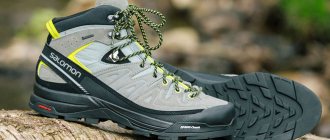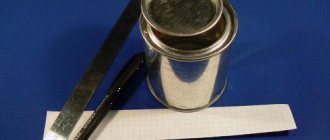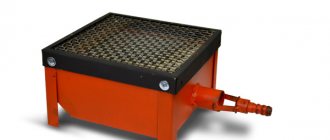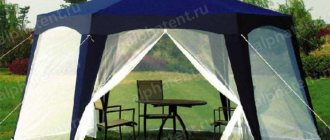Catalytic heating pad: what is it?
The catalytic heater is a technological breakthrough among existing heating devices, which is very popular both in Europe and in Russia.
The operating principle is as follows: heat generation occurs through oxidation. The body of the device is equipped with a catalyst plate; when fuel hits it, a reaction occurs, resulting in heat generation.
It is also important that the fuel is consumed without flame, which means that combustion products are not formed. Therefore, the catalytic heating pad is considered safe and environmentally friendly. In terms of efficiency, it surpassed conventional gas burners.
How does heating occur:
- the catalyst plate is heated to a temperature of 200 to 500 degrees;
- the fuel liquid is heated in a separate compartment;
- the red-hot fiberglass plate is covered with vapors of the burned fuel;
- the combustion process without flame occurs under the influence of a catalyst.
Depending on the type of fuel used, there are several types of catalytic heating pads:
- The most common is the catalytic gas heating pad, which uses liquefied gas in cylinders. This type of tourist heater is designed for the use of disposable propane cylinders. They are inserted into the device body and connected through a hose. As an option, you can also connect a household cylinder used for cooking to the gas catalytic heating pad.
- Gasoline catalytic heating pad. This model is equipped with a special tank equipped with a catalytic cartridge. When fuel vapor gets on the cartridge, an oxidation reaction begins. A catalytic tent heater running on gasoline is lightweight and small in size.
- Devices running on industrial alcohol. Such models are equipped with a special compartment inside the body, which houses a container with alcohol or dry fuel. Their maximum weight is 2 kg. Good for heating tents, heating food and drying clothes and shoes.
- Combined fuel. Such models are considered the most convenient, because any type of fuel is suitable for their operation. However, there is one drawback - their maximum power is 1200 W.
Good day. I would like to introduce you to such a useful device as a catalytic flameless heating pad. A little history. During the First World War, millions of soldiers froze in the trenches, and during the four war years, inventors in the United States, Japan and England patented several versions of pocket liquid heating pads. The principle of their operation was simple: catalytic flameless oxidation of alcohol or gasoline. Platinum served as the catalyst in all cases. The Japanese heating pad looked like a cigarette case, inside of which there was a reservoir filled with cotton wool and a platinum gasket. Holes were drilled in the housing to supply air to the catalyst and remove combustion gases. To start the heating pad, alcohol was poured into the tank, which soaked the cotton wool. Then the catalyst was heated with a match flame, and the catalytic reaction began. Currently, heating pads for individual heating of a person on a hiking trip, fishing, hunting, in conditions associated with outdoor work, winter sports, and so on have become quite widespread. Soviet industry produced a gasoline catalytic heating pad GK-1, which, when fully charged, could generate heat for 8-14 hours with a temperature of up to 60 °C, that is, at the pain threshold.
Catalytic heating pad GK-1. Assembled.
Catalytic heating pad GK-1. With the cover removed. The catalytic cartridge is visible.
Design and principle of operation
The heating pad consists of a reservoir filled with cotton wool, a nozzle with a mesh cartridge in which the catalyst is placed, and a lid with ventilation holes.
The operating principle of the heating pad is based on the release of heat during the flameless oxidation of gasoline vapor in the presence of a catalyst. Gasoline vapor from the tank passes through the catalytic cartridge, where it is oxidized by atmospheric oxygen (burns without flame) on the surface of the heated catalyst. Oxidation products escape into the ventilation holes of the lid. At the same time, air containing oxygen enters through the ventilation holes of the cover to the surface of the catalyst. The catalytic mesh (catalyst) has the form of a wick and is located inside a steel mesh cartridge, made of platinum - this is the most important part of the heating pad. To start, the grid in the catalytic cartridge is heated for 10-15 seconds using a flame that does not produce soot (for example, a lighter).
The fuel for the heating pad is highly refined gasoline. Gasoline for lighters or some types of nephrases are well suited for these purposes: C2-80/120 (Galosha gasoline) or C3-80/120. The use of other types of fuel can lead to rapid clogging of the catalytic grid, which will affect its efficiency. You can often increase the efficiency of a clogged catalyst by calcining the mesh cartridge with the catalyst inside on a non-smoking (gas) flame or in a muffle furnace.
Z.Y Thank you for your attention..)
How to refuel
Filling such a heater with fuel will not be difficult even for a novice tourist. The main thing is that the fuel is clean and intended specifically for a specific model, i.e., if it is a gasoline heater, then you need to use only gasoline and always of good quality.
A syringe is best for refueling, so you don't get your hands dirty or spill fuel. Using a syringe, gasoline can be poured directly into a tank or watering can.
Next, you need to put the cap on the tank and the lid on top. To make the heater work better, warm it up in your hands for a couple of minutes.
The cost of such a device depends on the model, type of fuel and brand.
How to properly handle the device
Having figured out the issue with fuel, you need to understand that the device is toxic. The decomposition products contain carbon monoxide, so it is better not to heat the catalyst in enclosed spaces or to use the device indoors only for testing.
The light weight and size allow you to take it in your hand, place it in your mitten or put the heating pad in your pocket. Resourceful users sometimes even put it in their shoes when it's cold. And camping heating of things like a sleeping bag is a classic use. When hunting, fishing or hiking, after getting your feet wet, it’s easy to dry both socks and shoes by using a couple of these devices.
After purchase, branded pocket heaters are recommended to be heated on gas, namely, the catalytic cartridge must be red-hot, why cool it at room temperature.
When starting a heating pad outside in cold weather, you need to warm the device in your hands to at least 15 degrees. Treat it like a frozen lighter, squeezing it tightly in your palm or warming it with your breath. Such actions must be done in order for vapor concentration to occur on the catalyst.
It has already been said about setting the device on fire, but for convenience, the lighter must be brought from the side, then even the slightest soot will bypass the catalyst mesh. Having completed all these steps, all that remains is to close the lid, place the device in the case or in another place. Gradually, the process of heat transfer will become noticeable.
But any process involving oxygen requires an air flow. It is not recommended to hide the burner under padding polyester or ventilated items. It's very easy to turn it off. Use any portable tool to remove the catalyst nozzle. The nozzle and body will cool down within a minute. Then you can assemble everything into one structure.
pros
The advantages include:
- compact dimensions and relatively light weight;
- no open flame, so there is no risk of burns or fire;
- all chemical processes occur inside the device, so it is considered environmentally friendly and safe;
- reusable, and with careful care – long service life;
- ease of operation and maintenance;
- efficiency (low fuel consumption);
- quick warming up of medium-sized tents.
Flaws
The catalytic heating pad has two disadvantages:
- the possibility of accidentally burning your hand if the gasoline that got into it during refueling did not have time to evaporate;
- inconvenient when used in enclosed spaces, since at the beginning of use it emits a characteristic odor of oxidation products.
You can warm up in a tent not only with a heating pad, but also with hot chocolate. And for this you need a good thermos. My article is devoted to thermoses: “How a thermos works and what types there are.”
Catalytic heating pad for hunting: pros and cons
We recommend viewing
photo: Andrey Kashkarova
From hunters' communication:
- Excuse me, is this your Catholic heating pad?
- Man, leave me alone, for Christ's sake, you Orthodox hot-water bottle!
When hunting or fishing, and even in cold weather, the weakest point of almost everyone is the legs.
In second place is the chest. When your feet start to freeze, you feel like you're completely frozen.
Even your hands can be quickly warmed up with simple exercises, but your legs, especially your feet, can’t be done without taking off your shoes.
Therefore, while the feet are warm, the general condition of the hunter is comfortable.
Practicing hunters are well aware that even after a couple of hours of active movement, when the feet are shod in boots or insulated boots (in any weather), the feet and socks are not dry. They are always damp, at least a little.
And this moisture is transferred to shoes, which are quite difficult to warm in the cold or in high humidity without removing your feet.
It’s almost impossible: it’s impossible to warm, let alone dry, wet boots even at a slightly negative temperature of -10°C outside without special equipment.
Therefore, drying shoes overnight in winter is out of the question. If you spend the night in a tent (in a sleeping bag), take off your shoes to dry them so that they do not freeze; experienced colleagues put them instead of a pillow under your head.
In addition to the legs (feet and calves), some of the useful places to “apply” a heating pad are the solar plexus area, on the chest or in the back area. To do this, it is convenient to tie a heating pad (in a case) to a cord worn around the neck.
If your feet or chest are frozen, it is not easy to warm up with one catalytic heating pad; it is better to have three of them (two in boots.
Case Study
I put catalytic heating pads in each boot, in a special stocking insert (one at a time), and I can responsibly say that once while hunting in the Vologda region the temperature dropped during the day by 10 degrees - from 20 to -30 ° C, and this saved my legs.
I recommend laying it where the caviar is. As a result, the legs are warm, the blood rises to the top and the whole body does not freeze.
Read the material “Keeping warm and warm while hunting”
A catalytic heating pad is generally known to many hunters - it is a device for individual, local warming without the help of an open fire; heat is generated through a chemical reaction with the oxidation of highly purified gasoline vapors.
Oxidation products exit the device through the ventilation holes in the lid. The design of a catalytic heating pad is relatively simple, because its body is made of thin stainless steel without additional or complex parts. There is a reservoir inside the housing, and a catalyst is attached to the neck.
The latter contains fiberglass, which is impregnated with gasoline. The neck is closed with a tight lid, but there are holes in it through which air enters the catalyst.
The catalyst, depending on the model, can have a different shape and composition; I have a titanium alloy version sprayed onto fiberglass.
Some call this fiber cotton wool, which is not entirely true. In modern catalytic heating pads there is often a catalyst in the form of a wick - this is the most important part of the heating pad. According to the instructions, we ignite the catalyst for 20-30 seconds, this requires one “long” hunting match.
photo: Andrey Kashkarova
It is not advisable to touch the catalyst with a match. The instructions say: “before starting work (starting the heater in heat release mode), it is necessary to warm up the body for 10-15 seconds, using an open fire that does not produce soot.”
It is turned off by cooling the heating pad by forcibly removing the cover or, as an option, removing the metal casing, completely insulating it from air. The heating pad stops giving off heat inertia.
Read the material “Testing the Zippo catalytic heating pad”
The body of the catalytic heating pad is made of stainless steel, the heating pad consists of: a lid, a nozzle with a catalyst, and a tank. In the tank, laid in layers, is not quite ordinary “cotton wool”, but asbestos tow.
Old-timer hunters claim that the Soviet heating pads of the GK-1 type did not use coated fiberglass, but a platinized metal mesh. But wouldn’t it be a pity to spend platinum on this matter?
Moreover, the modern “budget” solution using fiberglass makes sense: a larger reaction surface is used for the chemical reaction than in the sprayed mesh in the old GK-1.
However, GK-1 has many of its own positive distinctive features, which we will discuss below.
To start the process you need to do a little preparatory work. Warm the body of the heating pad, at least in your hands, to +30-35 degrees. The next step is to warm up the catalyst, and immediately after that wrap (or hide in your bosom) the catalytic heating pad.
This is difficult to do directly in the cold. The temperature of the catalyst will drop and the process will stall.
To start and maintain the process around the catalyst, a very small amount of air (oxygen) is needed, so the normal operating position of the heating pad is in a breathable cover and behind the bosom, in a clothing pocket or in a sleeping bag.
For effective operation (the maximum heating in my practice measured with a professional DVT thermometer was recorded at 70° C), a small amount of oxygen in the air next to the catalyst is sufficient - up to 5%.
photo: fotolia.com
After the catalyst has warmed up, the heat output of the heating pad quickly gains strength in a few minutes.
So, gasoline vapors undergo oxidation by oxygen on the surface of an already heated catalyst and burn without a flame. At the same time, air containing oxygen enters through them to the surface of the catalyst.
One full refill (48 ml - poured through a measuring funnel) is enough for 5-7 hours of effective operation at a temperature of 60-70 ° C. Then the temperature drops. In the effective mode, which I tested empirically, the consumption of purified gasoline was approximately 6 ml per 1 hour of operation.
Read the material “Active headphones: the all-hearing ear”
After this time, gasoline consumption decreases even more, in proportion to the thermal output of the device. The calorific value of gasoline is 44 mJ per 1 liter, with a density of 0.71. It follows from this that the flow rate for subsequent hours of operation with less thermal effect will be approximately 1 ml per hour.
Or otherwise, the power of the heating pad can correspond to values in the range of 12-25 W. So, the principle of operation is clear: gasoline vapors are oxidized by oxygen on the surface of an already heated catalyst and burn without flame.
At the same time, air containing oxygen enters through them to the surface of the catalyst. Even based on these calculated figures, and practice always makes its own adjustments to the calculation, it becomes clear that we are faced with only a local tool with a small thermal effect, which is inappropriate to use for more serious things, such as heating a car oil pan or even drying wet shoes .
If the operation of the heating pad is finished, there is no need to heat anything - just cool the heating pad, or remove the catalyst for a couple of minutes to cool and stop the chemical reaction. In this case, the remaining gasoline remains unused.
But I don’t recommend relying on the remainder, as it tends to evaporate. If the heating pad has been left for several days with this residue, you will have to refill it again. That is why I do not recommend filling the catalytic heating pad in advance and having 100-200 ml. purified gasoline with you - “in reserve”.
The “disadvantages” of catalytic heating pads of any model include a “difficult start”, including the possibility of accidentally burning your hand if the gasoline that got into the heating pad did not evaporate from it, and the inconvenience of using it in enclosed spaces, since for some time after the start of use there is a characteristic smell of products oxidation.
In comparison the truth is known. By the way, the Zippo catalytic heating pad has a guaranteed catalyst life of only 70 ignitions, while the “old Soviet” GK-1 catalyst lasts much longer; it lasts 10 times longer.
The catalyst is the most important and, by the way, removable, replaceable part of a catalytic heating pad of any model. It is a chemical that speeds up a reaction but is not consumed during the reaction.
Effective Alternatives
Another warming option is a chemical heating pad, manufactured today industrially and in the form of a package with a special composition: salt, aluminum, copper sulfate, sawdust.
You can make this “design” yourself by adding water; the only negative is copper sulfate, which can poison you. This composition is reminiscent of the modern Teploid sachet, which ROG has written about several times.
photo: fotolia.com
There is salt, copper sulfate, aluminum and zinc. If this composition is mixed with metal and water, heating occurs. If there is enough zinc or aluminum, a “geyser” of hot liquid may occur.
Read the material “Dressing according to the rules for hunting”
The disposable one acts without reaction with oxygen (air), at a low cost, comes in different sizes, and is designed accordingly for different times (3-6-12 hours).
The “disadvantage” of this method of local heating is that “Teploid” has a limited shelf life: if it sits idle for six months, its effective operation is not guaranteed.
Therefore, I recommend purchasing them not in reserve, but directly “fresh” before the winter hunting season.
How else can you stay warm without an open fire?
The topic is quite broad and there are many options. But one of the simplest and most accessible is local heating of the hands or an area of the body using a powerful electric flashlight.
Some modern LED flashlights with a lens produce such a powerful luminous flux that, when converted into heat, it burns holes in vests and peacoats - with prolonged use.
Reusable sodium acetate salt warmers are freely sold in the pharmacy chain. There are heating pads with electric heaters, but that's another story.
What to do?
A modern Chinese heating pad, no matter what its name, works unstable in practice - it can fry at +50°, or be barely warm. Such results depend on several factors: the quality of gasoline, the duration of preheating, the access of air during heat transfer mode, wear or contamination of the catalyst, etc.
Among the heating pads that are sold in Russia at a relatively low price - up to 1000 rubles, thin titanium coating is used as a catalyst coating, while the best result in terms of reliability, durability and, most importantly, heat transfer is given by the heating pad that did not skimp on the catalyst. and made it from titanium alloy.
My advice: for hunting in frosty weather, look in advance for an old Soviet catalytic heating pad (shaped like a harmonica) with a titanium mesh like GK-1. I don’t mind paying for something like this.
A little worse, in my opinion, is the Chinese model Kovea, and its body is the same as the Zippo model. Moreover, it is appropriate to mutually replace catalysts for these models. The Kovea model retails for one and a half times more than the Zipp model.
My conclusion: everything that is freely sold today in the segment of catalytic heating pads is not worth professional attention. They can be used to protect against frost during relatively long periods of hunting.
Yes, sometimes you have to use at least something, for lack of a better one, so I hope that the information presented about my practical experience of warming my legs and chest in frosty weather using several catalytic heating pads at the same time will be useful to my colleagues.
Source: ohotniki.ru
Interesting article to read:
- A simple and tasty way to eat while hunting
- There is nothing to do on a driven hunt without money
Use while hiking
If you need the heating pad to heat not all day, but for example, several hours, then refill it at the rate of 1 ml per 1 hour of operation. For reserve, you can add a few milliliters on top.
Despite the fact that the device itself is small in size, it is capable of maintaining heat in a room with an area of 15 to 25 m2. Therefore, the calculation of the number of devices per tent must be carried out based on these indicators.
The order of use is as follows:
- remove the lid from the heating pad, separate the wick;
- fill with fuel using a syringe or funnel;
- after filling the tank, remove the watering can and drain the remaining fuel (droplets that fall on the heater must be thoroughly wiped off);
- place the heating pad vertically and the wick on the filling hole;
- bring the lit lighter to the top of the wick, hold for 5-6 seconds;
- close the tank lid and place the heater in the case.
Important! For safety reasons, the heating pad must be kept in a case to eliminate the risk of skin burns. In addition, it will not overcool in the case.
The heating pad starts working at a temperature of 42-50 degrees. You can regulate the temperature by supplying air. The freer the air access, the higher the temperature will be.








